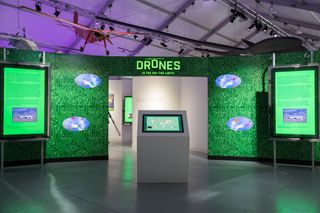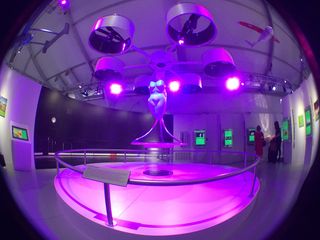New Drones Exhibit Has It All: Cool Tech, Games and Science

NEW YORK — Drones have come a long way since the clumsy, balloon-driven models that first took to the air during the 19th century.
Over the past few decades, and particularly in recent years, technology has rapidly improved to make drones smaller, faster, more robust and more maneuverable. Meanwhile, enterprising engineers and designers continue to push the limits for how drones can take on myriad tasks for military, industrial, scientific and personal purposes.
A new exhibit here at the Intrepid Sea, Air and Space Museum, "Drones: Is the Sky the Limit?", is the first to explore the ongoing story of drones — their origin and history, how their forms and uses have changed over time, and how we might deploy them in the future. [See Photos of the Drone Exhibit at the Intrepid Museum]
"The exhibit's a fabulous vehicle — no pun intended! — for the interplay of all these big ideas: science, technology, history and the arts," exhibit co-curator Elaine Charnov, senior vice president of exhibits, education and programming at the Intrepid Museum, told Live Science.
There are plenty of actual drones on display, representing a wide range of sizes and uses — from the Boeing Insitu ScanEagle, which is launched from a catapult and was instrumental in a Navy SEAL rescue operation against Somali pirates in 2009, to Volantis, the "drone dress" co-designed and worn by Lady Gaga in 2013.

One drone, which hangs from the exhibit ceiling, was used by scientists with the National Oceanic and Atmospheric Administration (NOAA) to capture data from hurricanes, Joseph Cione, a research meteorologist at NOAA, told Live Science.
Drones are particularly well-suited for investigating the area in a hurricane where the ocean and the atmosphere meet, Cione said. This zone is too low for scientists to explore in an aircraft, but it is vital for understanding hurricane dynamics, because "that's where the energy exchange comes from," he explained.
Sign up for the Live Science daily newsletter now
Get the world’s most fascinating discoveries delivered straight to your inbox.
Scientists had previously studied this region by dropping sensors attached to parachutes, but those provide only isolated snapshots of information, Cione said. However, a device like a drone — which is in continuous motion as it gathers data, and can stay aloft for up to 2 hours — can provide a more complete picture of what's happening inside a hurricane.
And more data helps researchers build better computer models, which, in turn, improves forecasting and can help to protect people and property, Cione said.
Scientists are even using drones in ways their designers may not have intended. For example, some marine biologists conduct DNA research on whales by deploying petri-dish-carrying drones that collect phlegm expelled from the whales' blowholes, according to Adam Lisberg, head U.S. spokesperson for drone-maker DJI.
"I promise you, DJI never imagined that as a use case when we were developing the drones," Lisberg told Live Science. "But it provides a huge advantage for the ability to monitor the health of whales without disturbing them."
"From scientists to construction firms to rescue services, they're putting our products to use in ways that we never even imagined," Lisberg said. [9 Totally Cool Uses for Drones]
Video screens at the exhibit display a variety of drones in action, while a "Drone Arts Theater" presents footage and still images shot by drones, showcasing the unique perspective that they capture by transporting cameras to otherwise inaccessible places. A kiosk with an array of touch screens offers the opportunity to explore predictions for possible future uses of drones — as pet sitters, dinosaur-fossil hunters or defense against disease-carrying mosquitoes.

Visitors can also peer through goggles that give them a drone's-eye view of a racecourse, or try their hand at flying a virtual drone. With the digital interactive tool "Take Control of a Drone," users navigate an aircraft over New York City, collecting tokens and avoiding the red "no-fly" zones. Those who are feeling especially adventurous can even take control of an actual tiny drone inside a net enclosure, and guide it through a series of obstacles.
Some of the drone technology described in the exhibit, such as flying cars, isn't quite ready for prime time just yet. But "we're closer than we've ever been" to these tantalizing visions of the future, said exhibit co-curator Missy Cummings, director of the Humans and Autonomy Laboratory at Duke University in North Carolina.
"That's not to say it's going to be here tomorrow," Cummings told Live Science. "But the technology does exist, so it's only a matter of time before these things get cheaper and easier to fly. And the regulatory environment will be more friendly to drones in the future."
By presenting the past and present successes and challenges of drones, the exhibit could spark eye-opening conversations among visitors about how drones might inhabit our lives in the years to come, Charnov told Live Science.
"We hope this will prompt people to get more familiar with the range of possibilities that drone technology provides," she said.
"Drones: Is the Sky the Limit?" will be on display at the Intrepid Sea, Air and Space Museum from May 9 through Dec. 3, 2017.
Original article on Live Science.

Mindy Weisberger is an editor at Scholastic and a former Live Science channel editor and senior writer. She has reported on general science, covering climate change, paleontology, biology, and space. Mindy studied film at Columbia University; prior to Live Science she produced, wrote and directed media for the American Museum of Natural History in New York City. Her videos about dinosaurs, astrophysics, biodiversity and evolution appear in museums and science centers worldwide, earning awards such as the CINE Golden Eagle and the Communicator Award of Excellence. Her writing has also appeared in Scientific American, The Washington Post and How It Works Magazine.
Most Popular


